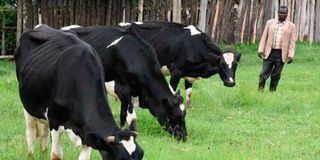Climate fact check: Cows, other ruminants produce methane

A farmer grazing cows. To reduce methane being produced by livestock, methane reducing feed additives and supplements are encouraged.
On October 29, an Instagram user by the name Anthony Gustin posted a photo in his Instagram account showing cows grazing in a field, accompanied by the caption: There are no greenhouse gas emissions in this photo.
He went ahead to say: “For those who shout "But what about methane?!"You have to ask two questions: Where does it come from? And where does it go? A natural biogenic cycle as old as time ≠ jacking tons of stored elements from under the Earth's crust into the atmosphere in a one way direction.
“Are we really supposed to believe that a mammal living as it should in harmony in its natural environment somehow "emits" a toxic gas that is bad for the planet and we as humans must reduce their population to save the planet from destruction? Don't believe the lies.”
This claim is, however, false. Science has proved that all animals, not just cows, produce methane.
Let’s talk Science explains that cows release methane mainly through their belches and flatulence. The types of foods fed to cattle also determines the amount of methane produced.
University of California, Davis (UC Davis) explains in an article that cattle are the number one agricultural source of greenhouse gases worldwide. Each year, it states, each cow will belch about 99 kilogrammes of methane.
“Methane from cattle is shorter lived than carbon dioxide but 28 times more potent in warming the atmosphere. Methane also stays in the atmosphere for about 12 years. After about 12 years, 80 to 89 percent of methane is removed by oxidation As a result of its short lifespan, methane is only significantly warming our atmosphere for those 12 years, which is why it is considered a short-lived climate pollutant.
“However, methane from fossil fuels does not have the same characteristics as biogenic methane. While both biogenic and methane from fossil fuels are chemically identical, the resulting CO2 from oxidation has a different warming impact. The biogenic carbon from cattle and wetlands is returned to the atmosphere as that is where it started, while fossil carbon is brand new atmospheric carbon, and hence, new warming,” says UC Davis.
“Methane’s warming impact isn’t determined by how much is being emitted – since it’s destroyed relatively quickly – but by how much more or less methane is being emitted over a period of time. This is a change in the rate of emission,” adds UC Davis.
The Department of Primary Industries and Regional Development notes that cattle should not be the only ones to be blamed for production of methane, because methane is produced by all ruminants, including sheep, buffaloes, goats, deers and camels.
“Ruminant livestock have a four-stomach (or rumen) containing microbes called methanogens, which are capable of digesting coarse plant material and which produce methane as a by-product of digestion (enteric fermentation): this methane is released to the atmosphere by the animal belching,” they say.
To reduce methane being produced by livestock, methane reducing feed additives and supplements are given to livestock to inhibit methanogens in the rumen, which subsequently reduces enteric methane emissions. These additives and supplements include synthetic chemicals, natural supplements such as seaweed and fats and oils.
“Feeding one type of seaweed at three percent of the diet has resulted in up to 80 percent reduction in methane emissions from cattle. Fats and oils show the most potential for practical application to farming systems and have shown methane emission reductions of 15–20 percent,” states the Department.
Currently, there are two approved ways under the Emissions Reduction Fund (ERF), which include feeding nitrates to beef cattle and feeding dietary additives to milking cows.
“Adding nitrates to the diet at a specified rate optimises rumen fermentation, and changes the pathway of hydrogen to produce ammonia rather than methane. This can have the dual effect of reducing methane emissions while improving or maintaining animal performance. We recommend that producers seek specialist advice before using this option because overdosing can result in nitrate poisoning. The use of dietary additives is currently approved only for grazing milking cows, and includes the addition of eligible additives to increase fat content of the diet to reduce methane emissions,“ says the Department.
However, there are risks from using the feed additives, which include toxicity leading to ill health and even death of livestock if the nitrate supplements are introduced suddenly or ingestion is too high.
- This fact check was produced by Daily Nation with support from Code for Africa’s Pesa Check, International Fact Checking Network, and African Fact Checking Alliance Network.





